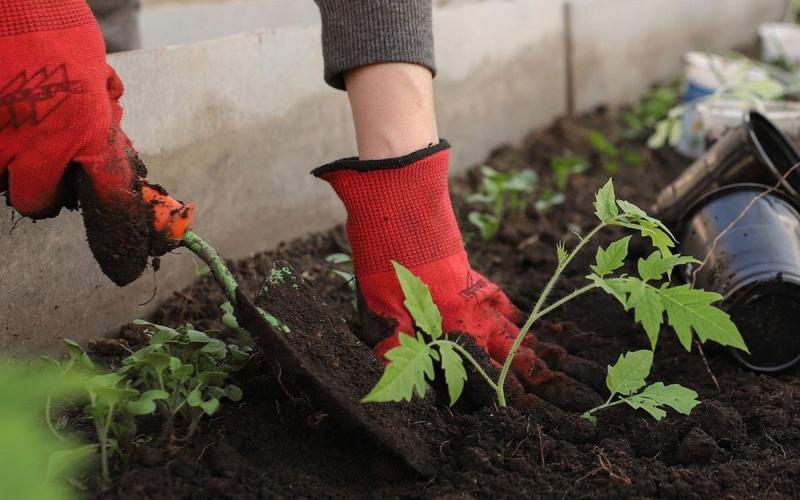Written by Sara Ogan, SDSU Extension Horticulture Assistant, under the review and direction of Robin Buterbaugh.
Description

General Description
Sweet potatoes, Ipomea batatas, are a vine in the morning glory family and not related to regular potatoes in the nightshade family.
Sweet potatoes are native to Central and South America and their tasty orange flesh is a dietary staple in warm climates.
The edible part of the sweet potato is a true root, called a storage root, not a tuber. The storage root will continue to get bigger as long as the plant continues to grow.
Ornamental sweet potato vines also produce storage roots; however, these plants have been developed for their foliage and will not taste very good. Make sure to grow an edible variety when adding this delicious crop to your garden.
Planting

Timeline
Because sweet potatoes are a tender vegetable, they should not be planted until all danger of frost is over and the soil temperature at a 4-inch depth is at least 65°F (Figure 1).
Varieties
Look for varieties such as Beauregard, Georgia Jet or Centennial which have a maturity of 90-100 days to align with South Dakota’s shorter growing season. If you are concerned about the sprawling vines associated with the sweet potato, bush type plants such as Vardaman or Porto Rico are an option.
Growing Slips
Sweet potatoes are grown from slips, which are sprouted from the root (Figure 2). Slips can be purchased from a nursery or garden center, or you can also grow your own slips.

To grow your own slips, choose organically grown sweet potatoes, as store bought sweet potatoes are often chemically treated to prevent sprouting during storage. Cut the sweet potatoes in half and place the cut ends in either a jar of water or into moistened potting mix. Place the sweet potato starts in a warm, sunny location, or under grow lights. If using the water method, maintain water levels in the jar. For the potting mix method, keep the soil moist; covering the starts with clear plastic will keep the soil from drying out too quickly. Once the slips have grown 5-6 inches tall and have developed several green leaves and some roots, “slip” the sprout with roots off the tuber by twisting it. You can also remove the slips by slicing them off the tuber, similar to a regular potato. This ensures that the roots remain attached. Start slips indoors about 8 weeks before the last frost in your area.
Spacing
Plant slips 12 inches apart and 4-6 inches deep, with several nodes underground and several leaves above ground. Plant in ridges or rows that are 36” to 40” inches apart. If utilizing the ridge method, mound up soil 8” to 12” high and 12” wide. Ridges help the soil warm faster, improve soil drainage, and make harvesting easier.
Plant Care

Watering
Sweet potato slips are tender, so water regularly after planting to help the plants establish. Consider planting on a cloudy day or in the evening to reduce plant stress.
Cold Sensitivity
Sweet potatoes can be damaged by temperatures below 50 degrees. Keep an eye on the weather and provide frost protection if necessary.
Soil Considerations
Sweet potatoes can be grown in most soil types, provided the soil is well drained. Limit nitrogen fertilizer as too much can stimulate vine growth rather than root development.
Common Pests and Diseases
Pests
Fortunately, sweet potatoes do not have many pest problems.
- Flea Beetles are insects around one-tenth of an inch long that feed on the leaves and stems. Physical barriers like floating row covers can help protect plants from flea beetle feeding.
Diseases
- Black rot (Ceratocystis fimbriata) is fungal disease that causes decay and rotting of the root.
- Scurf (Monilochaetes infuscans) is a fungal disease on the root surface. The injury is superficial, however, and does not affect eating quality.
These soil borne diseases are best controlled by using disease-free slips and rotating beds to crops other than sweet potatoes. Let soil dry out between irrigation as wet soil promotes root rot.
Harvesting

Harvest Tips
Harvest roots when they reach 5 to 6 inches in length and about 2 inches in diameter. Complete the harvest before a killing frost. Once there has been a hard frost and the tops are completely dead the roots are at risk of rotting.
Harvest sweet potatoes gently, taking care not to bruise or damage the skin. Cut sweet potato vines back to the base of the plant. Use a potato fork to loosen soil under or around the roots. Lift gently and remove any soil clumps from the harvested sweet potatoes.
To prevent rotting, do not wash them until consumption. If the weather is dry, let them sit in the sun for several hours before bringing them in.
Storage, Nutrition, and Preparation
Storage and Curing
Curing the sweet potatoes will improve their quality and help them keep longer. To cure, provide warmth (80°F to 90°F) and high humidity for 7 to 14 days. Cure in a single layer with space between them for air circulation. When the skins are dry the potatoes can be put into storage in a cool dry location (50-60°F) for 3-4 months.
Properly stored, some varieties will last up to a year. Sweet potatoes damaged during harvest should not be cured; they can be consumed immediately.
Nutrition Facts
Sweet potatoes are an excellent source of vitamin A and vitamin C. They are also a good source of fiber, potassium, and vitamin B-6.
Cooking
Sweet potatoes can be enjoyed baked, topped with cinnamon and brown sugar. Use them pureed in baked goods and soups. They can be roasted with other complementary fruits and vegetables or even made into fries.For recipes and more information, view our Pick it! Try it! Like it! resource for sweet potatoes.
Additional Resources
- Sweet Potatoes, a Winning Vine for Your Garden, PennState Extension.
- How to Grow Sweet Potatoes in Your Garden, Utah State University.
- How to Grow Sweet Potatoes, MSU Extension.
- How to Grow Your Own Sweet Potato Slips, Piedmont Master Gardeners.


